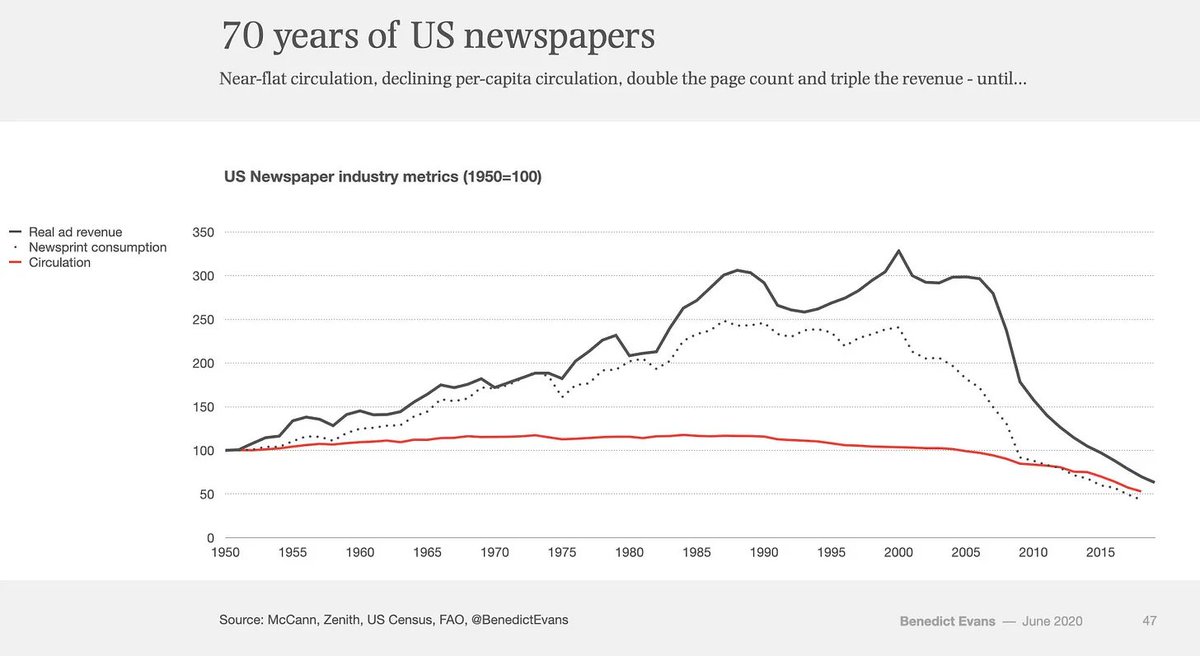Blockchain Changes Capital Flow: Blockchain allows capital to flow as quickly as data, enabling fragmentation and expansion of online economic interactions.
Integration of Social Networks and Exchanges: Future social networks may become exchanges, and vice versa. Polymarket and PumpFun are early examples.
A New World of Attention and Financialization: The combination of capital and attention is changing human behavior, and we have yet to fully understand its impact.
- From Newspapers to Social Networks: How Attention is Monetized
Decline of Newspapers: After the rise of the "information superhighway" in 1995, newspaper revenues began to decline.
The Click Era: Media no longer pursues the relevance of stories but rather how much emotion they can evoke. Thus, Elon Musk bought X (in pursuit of traffic) instead of The Washington Post.
Attention Commodification: Social networks quantify and fragment attention, selling it like pastries, shaping human thought at the cost of cultural and social impact.
- Social Networks are Essentially Exchanges
From Wall Street to Silicon Valley: After the 2008 financial crisis, quantitative talent moved to social platforms like Facebook, selling attention to the highest bidder.
Imbalance in Value Distribution: Creators and users receive almost no returns, while platforms monopolize value.
Alternatives?: Web3 may change the status quo, allowing value to flow faster and fairer through blockchain.
- Web3 Social Networks: Financialization and Incentives
The Power of Blockchain: Funds move at the speed of data, and social networks can redesign business models through financialization.
Case Studies:
AI Token $GOAT reached a market cap of 400 million, driven by speculation. People invest to sell to the next buyer, rather than for community belonging.
MEME assets resemble social networks, gathering crowds through capital and attention, but without long-term value, they may resemble Ponzi schemes.
Farcaster and Degen:
Farcaster initially grew through core users (crypto founders), while Degen introduced a tipping system (10 million transactions, 784,000 wallets).
Creators are rewarded for contributions, separating financial incentives from social interactions, blurring the lines of attention-financialization.
- Attention-Financialization Spectrum
Examples at Both Ends:
Attention End: Twitter, TikTok, where users exchange time for dopamine.
Financialization End: Reddit's Gamestop event, PumpFun, where users gather for profit.
Hybrid Model: Social networks either evoke emotions or provide capital, driving user participation.
- Future Outlook
Evolution of Social Networks: It will not be "a better Twitter," but rather an exchange that integrates speculation, ranking, and ownership.

免责声明:本文章仅代表作者个人观点,不代表本平台的立场和观点。本文章仅供信息分享,不构成对任何人的任何投资建议。用户与作者之间的任何争议,与本平台无关。如网页中刊载的文章或图片涉及侵权,请提供相关的权利证明和身份证明发送邮件到support@aicoin.com,本平台相关工作人员将会进行核查。




